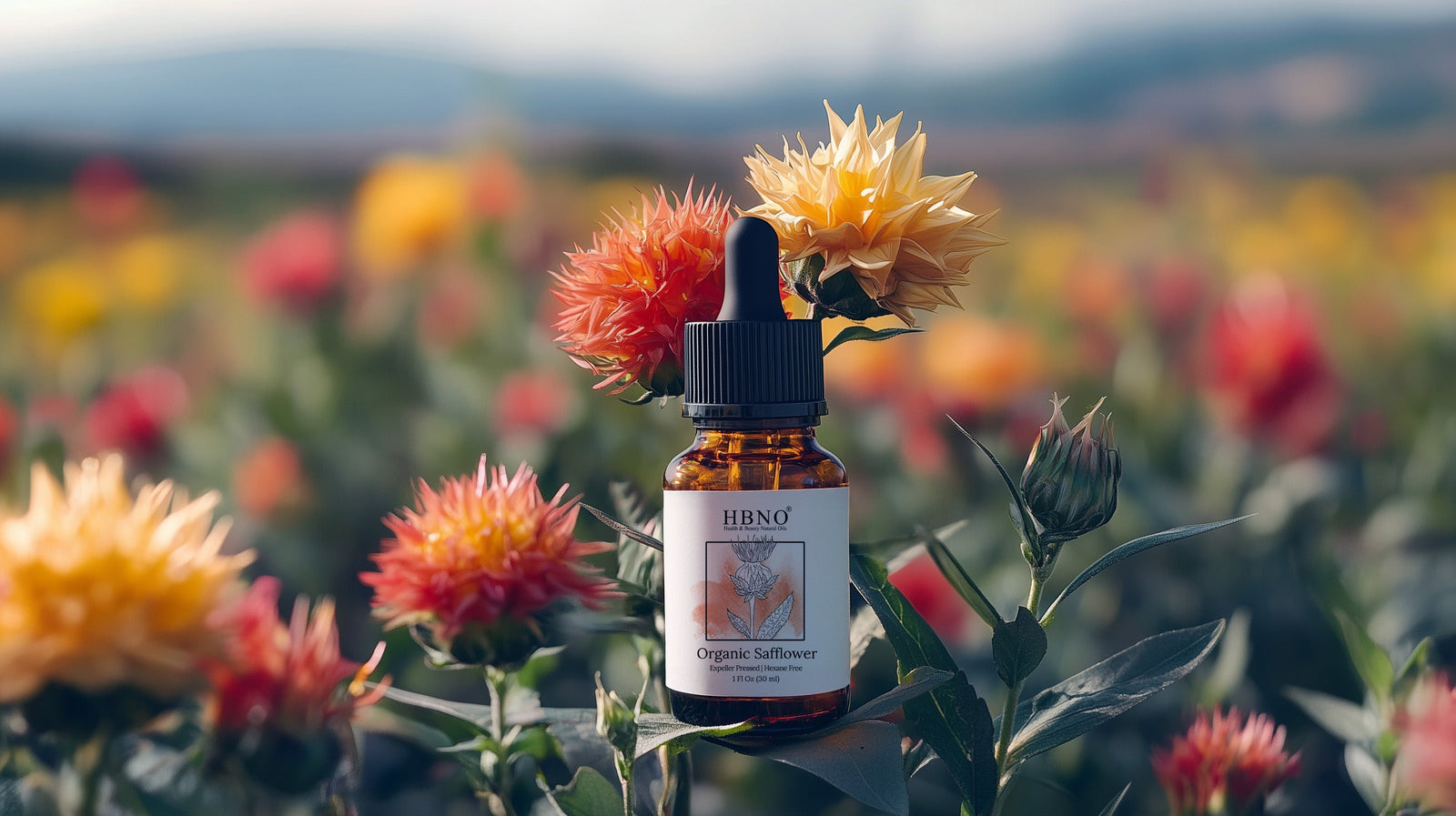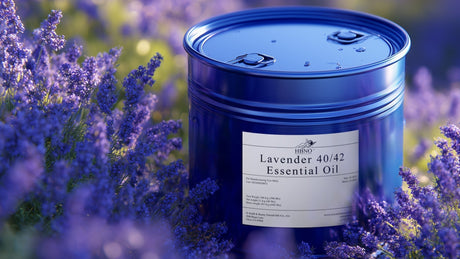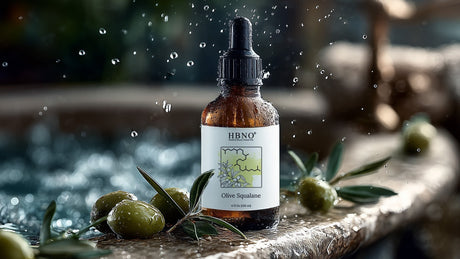The Wonders of Safflower Oil lie in its versatility and nourishing properties. Safflower Carrier Oil, derived from the seeds of the Carthamus tinctorius plant, comes in two main types-High Oleic and Linoleic Safflower Carrier Oil-making it a popular choice for skincare, haircare, massage, and even culinary use.
The difference between linoleic vs high oleic safflower oil lies in their fatty acid profiles, which determine their best uses.
High Oleic Safflower Carrier Oil: Overview
Composition and Stability
High Oleic Safflower Carrier Oil is characterized by its high concentration of oleic acid, a monounsaturated omega-9 fatty acid. This oil typically contains 75% to 85% oleic acid, which lends it exceptional oxidative stability, meaning it resists going rancid and has a longer shelf life than polyunsaturated oils.
Thanks to this stability, High Oleic Safflower Oil may withstand high temperatures, making it ideal for both culinary use (like sautéing and baking) and personal care formulations where product longevity is important.
Benefits of High Oleic Safflower Oil
1. Moisturizing Dry Skin
Oleic acid is highly moisturizing and may help the oil penetrate deep into the skin. This makes it particularly beneficial for individuals with dry, flaky, or mature skin.
2. Anti-Inflammatory Properties
It has mild anti-inflammatory benefits, which may help calm redness or irritation, especially in sensitive or reactive skin.
3. Massage Oil Base
Due to its smooth texture and absorbency, High Oleic Safflower Carrier Oil is widely used in massage therapy and body oils, offering glide without greasiness.
4. Hair Conditioning
While not as lightweight as the linoleic version, the high oleic variant still softens and smooths hair, making it a suitable ingredient for hair shampoos and conditioners.
5. Culinary Uses
High Oleic Safflower Oil is favored in cooking for its neutral flavor and ability to withstand high-heat methods such as frying and roasting.
Linoleic Safflower Carrier Oil: Overview
Composition and Characteristics
Linoleic Safflower Carrier Oil contains a high percentage of linoleic acid, a polyunsaturated omega-6 fatty acid. On average, this oil features around 65% to 75% linoleic acid, which makes it thinner in consistency and more suitable for oily or acne-prone skin.
Unlike the high oleic variant, linoleic oil is less heat stable, meaning it oxidizes faster and is not recommended for cooking. It is better stored in cool, dark places to extend its shelf life.
Benefits of Linoleic Safflower Oil
1. Balances Oily Skin
Individuals with acne or oily skin often have low linoleic acid levels in their sebum. Applying Linoleic Safflower Carrier Oil may help unclog pores and prevent breakouts.
2. Non-Comedogenic
This oil is very light and non-greasy, absorbing quickly into the skin without clogging pores-making it ideal for facial serums and light moisturizers.
3. Improves Skin Conditions
With natural anti-inflammatory and skin-repairing properties, it may be helpful in managing eczema and rosacea.
4. Hair and Scalp Support
Linoleic acid may promote scalp health and reduce dryness and flakiness. It also helps in strengthening hair follicles and promoting a healthy shine.
5. Ideal for Sensitive Skin
Its gentle, soothing nature makes it an excellent choice for those with reactive or delicate skin, including babies and individuals with chronic dermatitis.

Linoleic vs High Oleic Safflower Oil: Key Differences
|
Feature |
High Oleic Safflower Carrier Oil |
Linoleic Safflower Carrier Oil |
|
Dominant Fatty Acid |
Oleic acid (monounsaturated) |
Linoleic acid (polyunsaturated) |
|
Skin Type Suitability |
Dry, mature, or sensitive skin |
Oily, acne-prone, sensitive skin |
|
Absorption Rate |
Moderate |
Fast |
|
Shelf Life |
Long |
Short to medium |
|
Oxidation Resistance |
High (heat stable) |
Low (prone to oxidation) |
|
Cooking Suitability |
Yes (high-heat safe) |
No |
|
Best Uses |
Massage oil, moisturizers, cooking oil |
Facial oils, acne treatments, scalp care |
|
Comedogenic Rating |
Low |
Very low |
Which One Should You Choose?
When comparing linoleic vs high oleic safflower oil, your choice should depend on how you plan to use it:
1. For Skin Care:
If you have oily or acne-prone skin, go with Linoleic Safflower Carrier Oil. Its light consistency and non-comedogenic nature help to control excess oil and prevent clogged pores. For dry or aging skin, High Oleic Safflower Carrier Oil offers deeper hydration and nourishment.
2. For Hair Care:
Both oils are beneficial, but linoleic acid helps reduce dandruff and inflammation, while oleic acid adds moisture and softness. Choose based on your hair and scalp needs.
3. For Massage Therapy:
High Oleic Safflower Oil is preferred due to its longer shelf life, smooth glide, and medium absorption.
4. For Cooking:
Only High Oleic Safflower Oil is recommended. It has a high smoke point (up to 450°F/232°C), neutral flavor, and health-promoting monounsaturated fats.
5. For DIY Formulations:
Use Linoleic Safflower Carrier Oil in lightweight serums or facial oils, and High Oleic Safflower Carrier Oil in creams, balms, and body butters.
Final Thoughts
Choosing between linoleic vs high oleic safflower oil depends entirely on your individual needs. Whether you're crafting a nourishing skincare formula, seeking a gentle oil for acne-prone skin, or looking for a stable culinary oil, safflower offers a solution in both forms.
Both High Oleic Safflower Carrier Oil and Linoleic Safflower Carrier Oil are derived from the same plant but deliver distinct benefits. Knowing the key differences empowers you to make the most informed decision for your health, beauty, or business needs. For formulators and manufacturers, sourcing HBNO Bulk Safflower Oils ensures consistent quality, purity, and performance at scale.
Stock up with a Private Label Manufacturing Services ensuring quality sourcing and efficient supply chain support.



